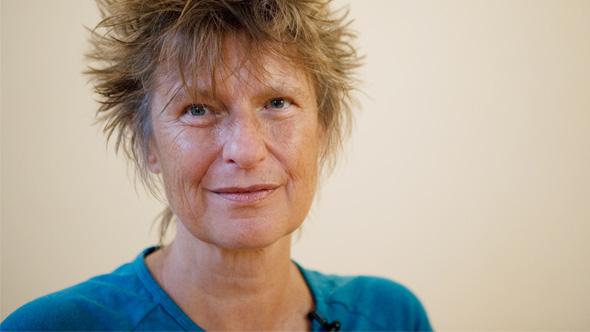by Monica Voss
I am often asked what style of yoga I teach. Since there is no short answer to this question, and I have the forum and opportunity here, I will attempt to tell the story of my longtime involvement with yoga.
Primarily, I was and still am inspired by the teaching of Vanda Scaravelli who lived in Fiesole, just outside Florence Italy, and passed away in 1999. More than anyone else, she spoke to my essential creativity and stirred my imagination. Vanda was introduced to the yoga postures by B.K.S. Iyengar in the late 1950’s at the suggestion of her friend J. Krishnamurti, who felt his students needed a physical practice. She studied with Iyengar every summer for about 5 years, after which time Krishnamurti began to bring T.K.V. Desikachar to Europe instead. From him, Vanda learned to integrate the breathing into her practice. By the time I met her in 1986, Vanda had been experimenting on her own without a teacher for decades. In 1992 in Toronto, Vanda was reacquainted with B.K.S. Iyengar, not having seen him for more than 30 years.
Vanda always found the postures easy. She had in many respects perfect yoga proportions: long limbs, flexible joints and a short spine. But she began to notice how tired her yoga friends were after practising, and her personal goal became to find a kinder, deeper approach, one more in tune with the natural waves of energy in the body. She was a unique individual who completely trusted her body’s intelligence. She discovered, rather than invented, basic truths about the body based on hours of daily practice, reading, and experiments with Tai Chi, Egyptian dance, and musical form. She was an innovator, a tireless pioneer who convinced her students that if they dropped inside, they, too, would make important discoveries.
Esther Myers and I began studying with Vanda in the mid-eighties. Every year, Vanda visited her daughter in Toronto, rested, wrote, and taught, traditionally, one-on-one. As she was opposed to anything that smacked of guru-worship, Vanda asked that her name not be used to describe a “method” of yoga. Therefore, we took the foundation of Vanda’s approach – the breath, the positive pull of gravity and the spontaneous release of the spine – and explored and expanded our own vision of hatha yoga. It is a vision that is alive, vibrant, intelligent, and one that with Tama Soble, my partner in Esther Myers Yoga Studio since Esther’s death in 2004, I am constantly reconsidering and reworking. Our approach is inclusive and evolving. We embrace any practice, from any tradition, as long as it brings awareness and vitality directly to the geographic, energetic and developmental centre of the human organism – the spine. In that way, I remain true to the basic principles and experimental spirit of Vanda’s work.
Our yoga practice is conceptual. Depending on how the mind works, one can weave a yoga practice from an idea, an image, a pranayama, a part or system of the body, one of the senses, or a traditional posture or series of postures. The genesis or inspiration, warp and woof can be almost anything. We plant a seed idea, then grow a practice or lesson whose roots are deep, healthy, and centered, and that expresses energy and beauty, because it is dependant on internal process, the laws of nature, not perfection or performance. The result is profoundly individuated.
The three basic elements underlying the process are universal life skills. With conscious breathing, by grounding our feet in the earth, and by freeing the spine of tension, we learn to accept change with flexibility and equanimity, and experience freedom and great joy. From that viewpoint, the asanas – any and all of the asanas – become true practices in living fully, deeply and authentically. Each session is unique and over time, this reflective approach becomes an effective and engaging moving meditation.
This is yoga that honours and celebrates the individual: Vanda’s incisive and original teaching, her eccentricities and musical talent; Esther’s analytical gifts, personal discipline, and steel-edged insight; my own innate and heart-felt connection to nature, to imagery, metaphor, literature and poetry; Tama’s creative and exciting thematic experimentation and her love of physical movement in all its forms. This yoga demands intelligence of the body and tremendous mental focus, and reinforces the naturally occurring conversation between body and mind, strengthening both. It promotes energetic curiosity and a rich inner life. This is yoga for the thinking body.
Published in the Yoga Festival Toronto Newsletter, June 2008

